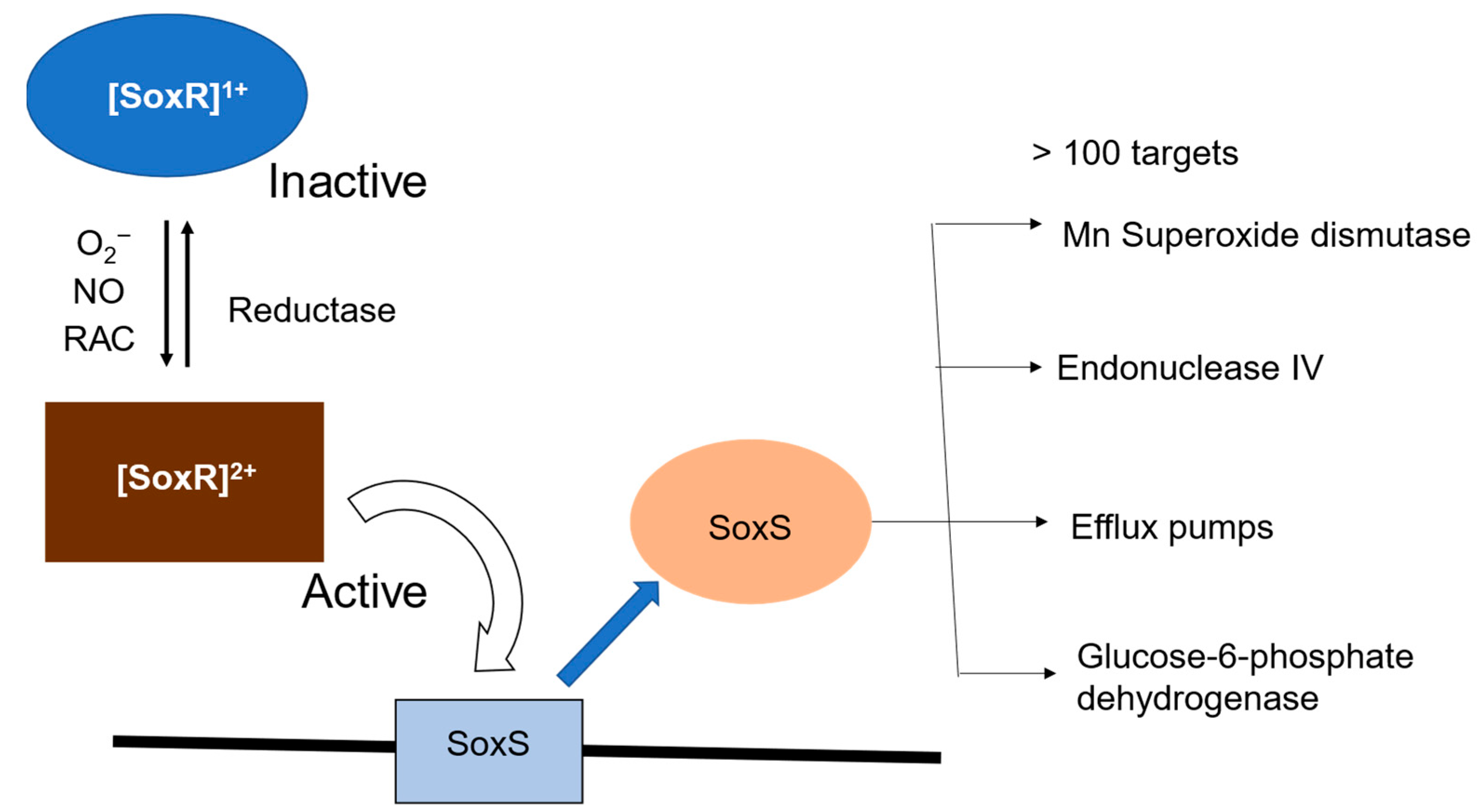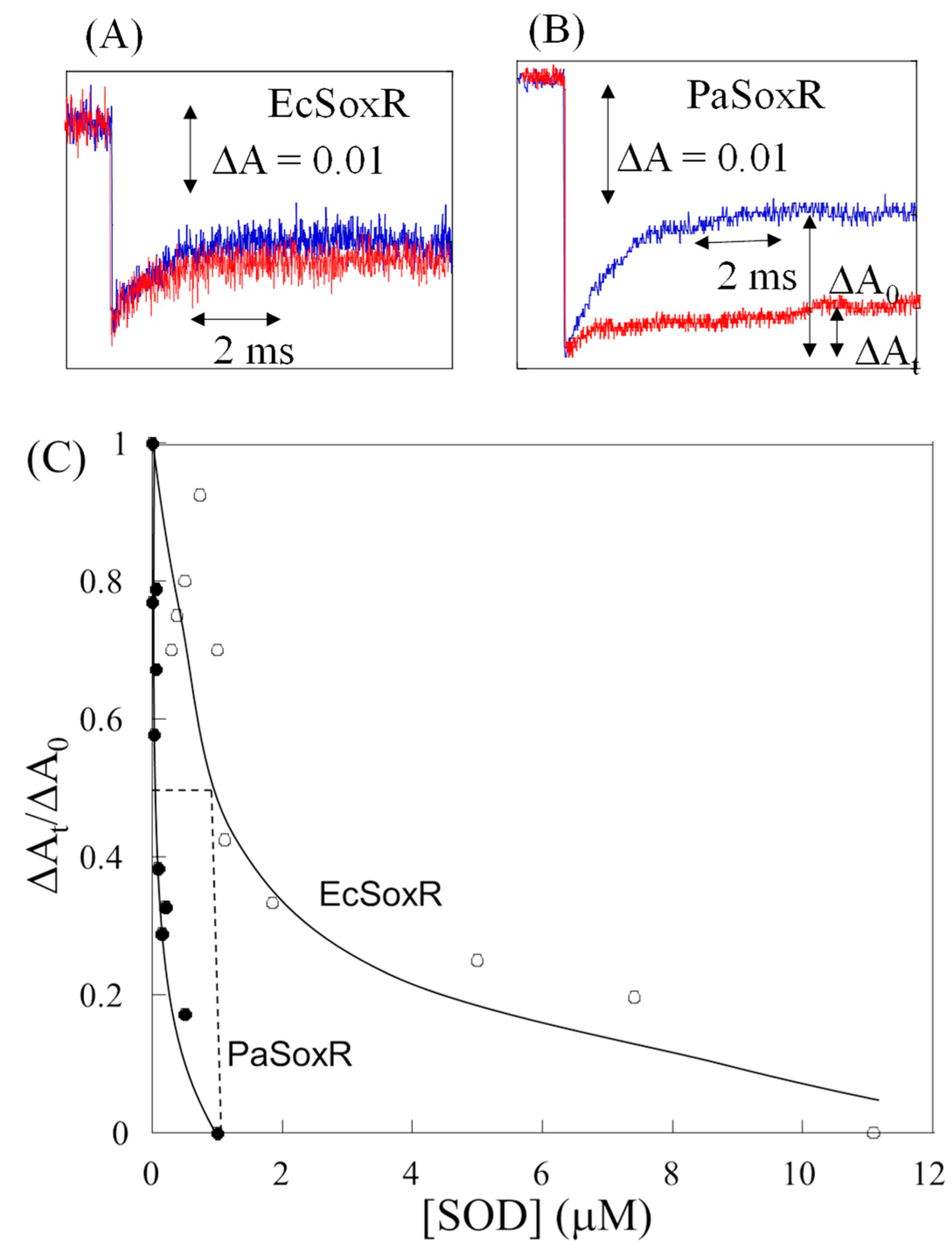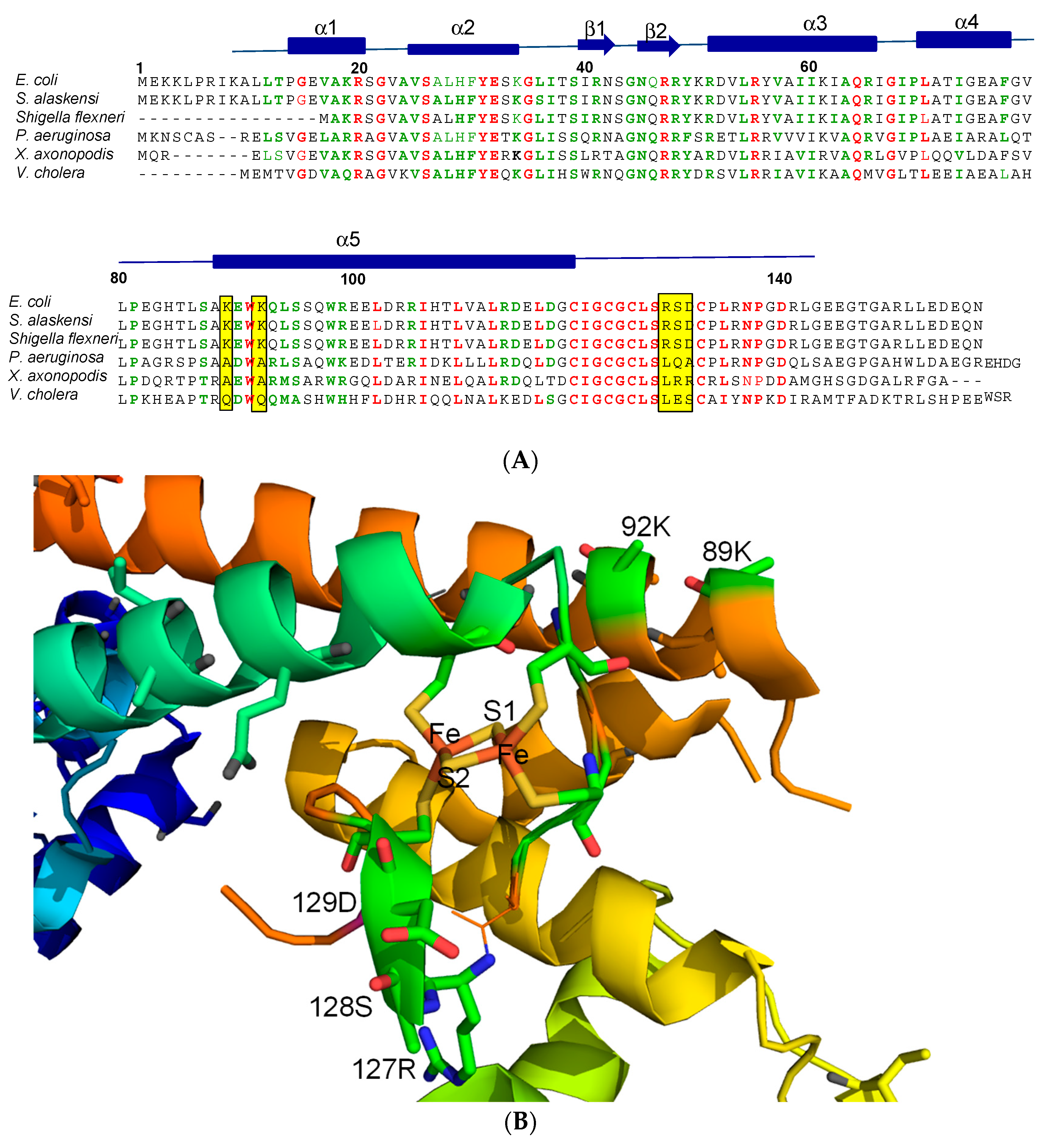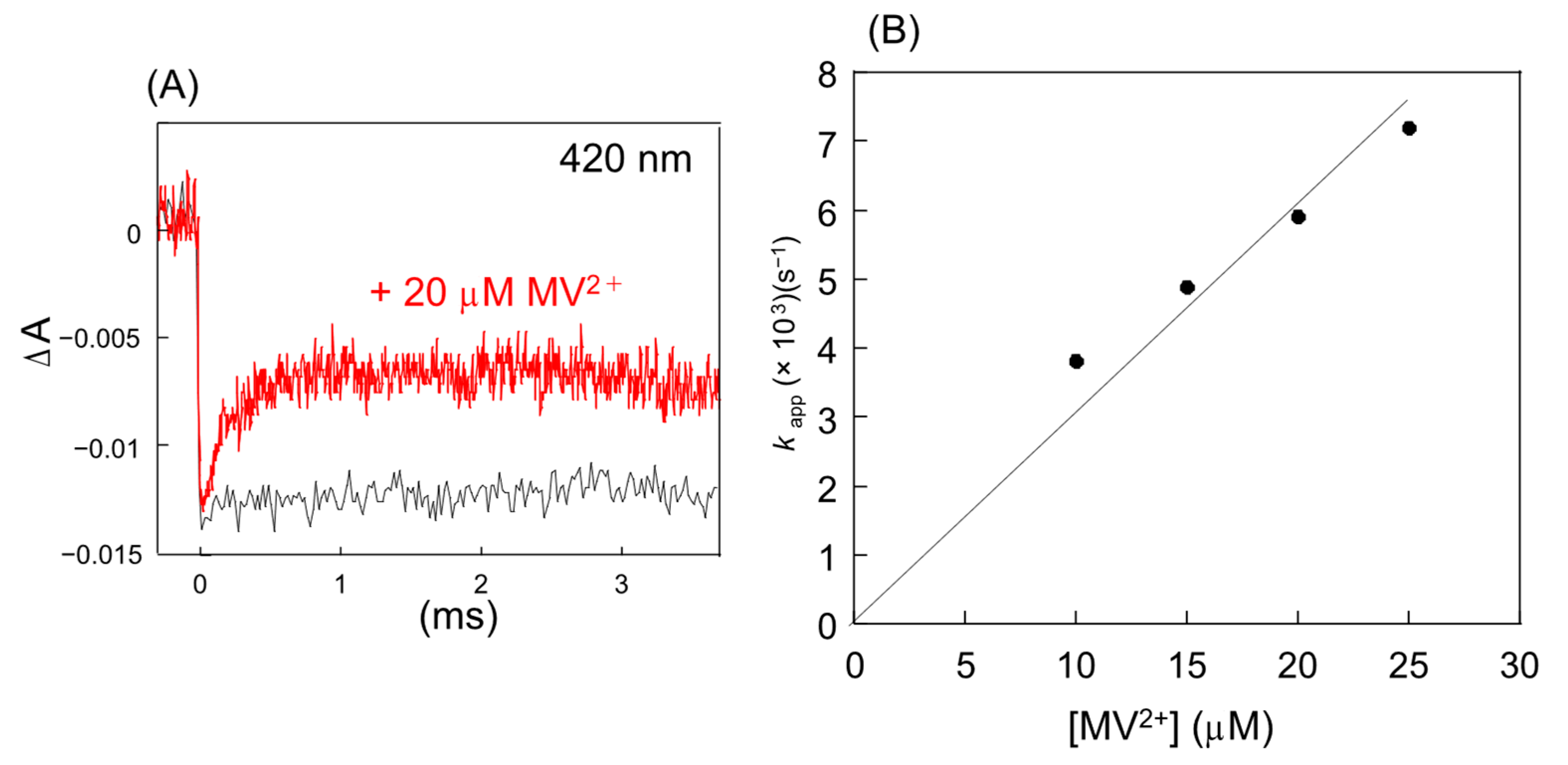Functional Diversity of the Oxidative Stress Sensor and Transcription Factor SoxR: Mechanism of [2Fe-2S] Cluster Oxidation
Abstract
1. Introduction
2. Direct Oxidation of [2Fe-2S] Cluster in SoxR by O2
3. Response of SoxR [2Fe-2S] to RACs

| RACs | E0 (vs. NHE) (mv) | EcSoxR k (× 108 M−1s−1) | PaSoxR k (× 108 M−1s−1) |
|---|---|---|---|
| MV2+ | −440 [34] | 3.0 | 3.0 |
| Dq | −358 [35] | 5.7 | 5.5 |
| Dur | −260 [35] | 2.1 | 2.6 |
| Pyo | −34 [36] | 7.1 | 6.8 |
| PMS | +80 [36] | 16.0 | 14.0 |
4. Physiological Significance of SoxR Response to O2− and RACs
5. Conclusions and Future Perspectives
Funding
Data Availability Statement
Conflicts of Interest
References
- Boncella, A.E.; Sabo, E.T.; Santore, R.M.; Carter, J.; Whalen, J.; Hudspeth, J.D.; Morrison, C.N. The expanding utility of iron-sulfur clusters: Their functional roles in biology, synthetic small molecules, maquettes and artificial proteins, biomimetic materials, and therapeutic strategies. Coord. Chem. 2022, 453, 214229. [Google Scholar] [CrossRef]
- Gupta, M.; Outten, C.E. Iron-Sulfur Cluster Signaling; The Common Thread in Fungal Iron Regulation. Curr. Opin. Chem. Biol. 2020, 55, 189–201. [Google Scholar] [CrossRef] [PubMed]
- Crack, J.C.; Green, J.; Thomson, A.J.; le Brun, N.E. Iron-sulfur cluster sensor-regulators. Curr. Opin. Chem. Biol. 2012, 16, 35–44. [Google Scholar] [CrossRef] [PubMed]
- Beinert, H.; Holm, R.H.; Münck, E. Iron-sulfur clusters: Nature’s modular, multipurpose structures. Science 1997, 277, 653–659. [Google Scholar] [CrossRef]
- Read, A.D.; Bentrley, R.E.T.; Archer, S.L.; Dunham-Snary, K.J. Mitochondrial iron-sulfur clusters: Structure, function, and an emerging role in vascular biology. Redox Biol. 2021, 47, 12164. [Google Scholar] [CrossRef]
- Bian, S.M.; Cowan, J.A. Protein-bound iron-sulfur centers. Form, function, and assembly. Coord. Chem. Rev. 1999, 190, 1049–1066. [Google Scholar] [CrossRef]
- Kiley, P.J.; Beinert, H. The role of Fe-S proteins in sensing and regulation in bacteria. Curr. Opin. Microbiol. 2003, 6, 181–185. [Google Scholar] [CrossRef]
- Ding, H.; Demple, B. In vivo kinetics of a redox-regulated transcriptional switch. Proc. Natl. Acad. Sci. USA. 2000, 97, 5146–5150. [Google Scholar] [CrossRef]
- Amábile-Cuevas, C.F.; Demple, B. Molecular characterization of the soxRS genes of Escherichia coli: Two genes control a superoxide stress regulon. Nucleic Acids Res. 1991, 19, 4479–4484. [Google Scholar] [CrossRef]
- Pomposiello, P.J.; Bennik, M.H.J.; Demple, B. Genome-wide transcriptional profiling of the Escherichia coli responses to superoxide stress and sodium salicylate. J. Bacteriol. 2001, 183, 3890–3892. [Google Scholar] [CrossRef]
- Kobayashi, K.; Fujikawa, M.; Kozawa, T. Oxidative stress sensing by the iron-sulfur cluster in the transcription factor, SoxR. J. Inorg. Biochem 2014, 133, 87–91. [Google Scholar] [CrossRef]
- Gaudu, P.; Weiss, B. SoxR, a [2Fe-2S] transcription factor, is active only in its oxidized. Proc. Natl. Acad. Sci. USA 1996, 93, 10094–10098. [Google Scholar] [CrossRef] [PubMed]
- Fujikawa, M.; Kobayashi, K.; Kozawa, T. Direct Oxidation of the [2Fe-2S] Cluster in SoxR Protein by Superoxide. Distinct Differential Sensitivity to Superoxide-Mediated Signal Transduction. J. Biol. Chem. 2012, 287, 35702–35708. [Google Scholar] [CrossRef] [PubMed]
- Blanchard, J.L.; Wholey, W.Y.; Conlon, E.M.; Pomposiello, P.J. Rapid changes in gene expression dynamics in response to superoxide reveal soxRS-dependent and -independent transcriptional networks. PLoS ONE 2007, 2, e1186. [Google Scholar] [CrossRef] [PubMed]
- Dietrich, L.E.P.; Teal, T.K.; Price-Whelan, A.; Newman, A.D.K. Redox-Active Antibiotics Control Gene Expression and Community Behavior in Divergent Bacteria. Science 2008, 321, 1203–1206. [Google Scholar] [CrossRef] [PubMed]
- Cruz, R.D.; Gao, Y.; Penumetcha, S.; Sheplock, R.; Weng, K.; Chander, M. Expression of the Streptomyces coelicolor SoxR Regulon Is Intimately Linked with Actinorhodin Production. J. Bactriol. 2010, 192, 6428–6438. [Google Scholar] [CrossRef]
- Shin, J.H.; Singh, A.K.; Cheon, D.J.; Roe, J.H. Activation of the SoxR Regulon in Streptomyces coelicolor by the Extracellular Form of the Pigmented Antibiotic Actinorhodin. J. Bacteriol. 2011, 193, 75–81. [Google Scholar] [CrossRef]
- Singh, A.K.; Shin, J.-H.; Lee, K.-L.; Imlay, J.A.; Roe, J.-H. Comparative study of SoxR activation by redox-active compounds. Mol. Microbiol. 2013, 90, 983–996. [Google Scholar] [CrossRef]
- Ma, Z.; Jacobsen, F.E.; Giedroc, D.P. Coordination Chemistry of Bacterial Metal Transport and Sensing. Chem. Rev. 2009, 109, 4644–4681. [Google Scholar] [CrossRef]
- Liochev, S.I. Is superoxide able to induce SoxRS? Free Radic. Biol. Med. 2011, 50, 1813. [Google Scholar] [CrossRef]
- Dietrich, L.E.P.; Kiley, P.J. A shared mechanism of SoxR activation by redox-cycling compounds. Mol. Microbiol. 2011, 79, 1119–1122. [Google Scholar] [CrossRef] [PubMed]
- Gu, M.; Imaly, J.A. The SoxRS response of Escherichia coli is directly activated by redox-cycling drugs rather than by superoxide. Mol. Microbiol. 2011, 79, 1136–1150. [Google Scholar] [CrossRef] [PubMed]
- Kuo, C.F.; Mashino, T.; Fridovich, I. Dihydroxyisovalerate Dehydratase. J. Biol. Chem. 1987, 262, 4724–4727. [Google Scholar] [CrossRef] [PubMed]
- Gardner, P.R.; Fridovich, I. Superoxide Sensitivity of the Escherichia coli Aconitase. J. Biol. Chem. 1991, 266, 19328–19333. [Google Scholar] [CrossRef]
- Gardner, P.R.; Fridovich, I. Superoxide Sensitivity of the Escherichia coli 6-Phosphogluconate Dehydratase. J. Biol. Chem. 1991, 266, 1478–1483. [Google Scholar] [CrossRef]
- Fujikawa, M.; Kobayashi, K.; Tsutsui, Y.; Tanaka, T.; Kozawa, T. Rational Tuning of Superoxide Sensitivity in SoxR, the [2Fe-2S] Transcription Factor: Implication of Species-Specific Lysine Residues. Biochemistry 2017, 56, 403–410. [Google Scholar] [CrossRef]
- Watanabe, S.; Kita, A.; Kobayashi, K.; Miki, K. Crystal structure of the [2Fe-2S] oxidative-stress sensor SoxR bound to DNA. Proc. Natl. Acad. Sci. USA 2008, 105, 4121–4126. [Google Scholar] [CrossRef]
- Getzoff, E.D.; Tainer, J.A.; Weiner, P.K.; Kollman, P.A.; Richardson, J.S.; Richardson, D.C. Electrostatic recognition between superoxide and copper, zinc superoxide dismutase. Nature 1983, 306, 287–290. [Google Scholar] [CrossRef]
- Ludwig, M.L.; Metzger, A.L.; Pattrige, K.A.; Stallings, W.C. Manganese superoxide dismutase from Thermus thermophilus: A structural model refined at 1.8 Å resolution. J. Mol. Biol. 1991, 219, 335–358. [Google Scholar] [CrossRef]
- Sheng, Y.; Abreu, I.A.; Cabelli, D.E.; Maroney, M.J.; Miller, A.-F.; Teixeira, M.; Valentine, J.S. Superoxide Dismutases and Superoxide Reductases. Chem. Rev. 2014, 114, 3854–3918. [Google Scholar] [CrossRef]
- Lee, K.L.; Singh, A.K.; Heo, L.; Seok, C.; Roe, J.-H. Factors affecting redox potential and differential sensitivity of SoxR to redox-active compounds. Mol. Microbiol. 2015, 97, 808–821. [Google Scholar] [CrossRef]
- Sheplock, R.; Recinos, D.A.; Macknow, N.; Dietrich, L.E.P.; Chander, M. Species-specific residues calibrate SoxR sensitivity to redox-active molecules. Mol. Microbiol. 2013, 87, 368–381. [Google Scholar] [CrossRef]
- Kobayashi, K.; Tanaka, T.; Kozawa, T. Kinetics of the Oxidation of the [2Fe-2S] Cluster in SoxR by Redox-Active Compounds as Studied by Pulse Radiolysis. Biochemistry 2025, 64, 895–902. [Google Scholar] [CrossRef] [PubMed]
- Steckhan, E.; Kuwana, T. Spectrochemical study of mediators. I Bipyridyum salts and their electron transfer to cytochrome C. Ber. Bunsenges. Phys. Chem. 1974, 78, 253–258. [Google Scholar] [CrossRef]
- Wardman, P. Reduction Potentials of One-Electron Couples involving Free Radicals in Aqueous Solution. J. Phys. Chem. Ref. 1989, 18, 1637–1655. [Google Scholar] [CrossRef]
- Moffet, D.A.; Foley, J.; Hecht, M.H. Midpoint reduction potentials and heme binding stoichiometries of de nova proteins from designed combinatorial libraries. Biophys. Chem. 2003, 105, 231–239. [Google Scholar] [CrossRef]
- Pomposiello, P.J.; Demple, B. Redox-operated genetic switches: The SoxR and OxyR transcription factors. Trends Biotechnol. 2001, 19, 109–114. [Google Scholar] [CrossRef]
- Gort, A.S.; Imaly, J.A. Balance between endogenous superoxide stress and antioxidant defenses. J. Bacteriol. 1998, 180, 1402–1410. [Google Scholar] [CrossRef]
- Kobayashi, K.; Tagawa, S. Activation of SoxR-dependent transcription in Pseudomonas aeruginosa. J. Biochem. 2004, 136, 607–615. [Google Scholar] [CrossRef]





| k × 108 (M−1 s−1) | |
|---|---|
| E. coli | |
| WT | 5.0 |
| R127LS128QD129A | 4.8 |
| D129A | 5.0 |
| K89A | 3.8 |
| K92A | 2.2 |
| K89AK92A | 0.33 |
| K89RK92R | 4.7 |
| K89EK92E | 0.31 |
| P. aeruginosa | |
| WT | 0.4 |
| A87K | 2.1 |
| A90K | 5.4 |
| L125RQ126SA127D | 0.4 |
Disclaimer/Publisher’s Note: The statements, opinions and data contained in all publications are solely those of the individual author(s) and contributor(s) and not of MDPI and/or the editor(s). MDPI and/or the editor(s) disclaim responsibility for any injury to people or property resulting from any ideas, methods, instructions or products referred to in the content. |
© 2025 by the author. Licensee MDPI, Basel, Switzerland. This article is an open access article distributed under the terms and conditions of the Creative Commons Attribution (CC BY) license (https://creativecommons.org/licenses/by/4.0/).
Share and Cite
Kobayashi, K. Functional Diversity of the Oxidative Stress Sensor and Transcription Factor SoxR: Mechanism of [2Fe-2S] Cluster Oxidation. Inorganics 2025, 13, 307. https://doi.org/10.3390/inorganics13090307
Kobayashi K. Functional Diversity of the Oxidative Stress Sensor and Transcription Factor SoxR: Mechanism of [2Fe-2S] Cluster Oxidation. Inorganics. 2025; 13(9):307. https://doi.org/10.3390/inorganics13090307
Chicago/Turabian StyleKobayashi, Kazuo. 2025. "Functional Diversity of the Oxidative Stress Sensor and Transcription Factor SoxR: Mechanism of [2Fe-2S] Cluster Oxidation" Inorganics 13, no. 9: 307. https://doi.org/10.3390/inorganics13090307
APA StyleKobayashi, K. (2025). Functional Diversity of the Oxidative Stress Sensor and Transcription Factor SoxR: Mechanism of [2Fe-2S] Cluster Oxidation. Inorganics, 13(9), 307. https://doi.org/10.3390/inorganics13090307






